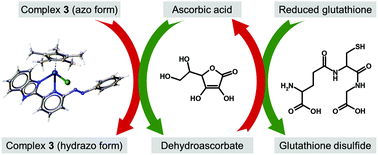Anticancer half-sandwich Ir(iii) complex and its interaction with various biomolecules and their mixtures – a case study with ascorbic acid†
Abstract
The extent of interactions with various biomolecules is a crucial feature of newly developed metallodrugs, worthy of thorough investigation, as its understanding helps uncover the fate of these xenobiotics in the physiological environment. In this work, promisingly cytotoxic half-sandwich complexes [Ru(η6-pcym)Cl(L1)]PF6 (1), [Ir(η5-Cp*)Cl(L1)]PF6 (2) and [Ir(η5-Cp*)Cl(L2)]PF6 (3), with 2-{n-[(E)-phenyldiazenyl]pyridin-2-yl}-1H-benzimidazole as a bidentate N-donor azo ligand (n = 5 for L1 and 6 for L2; pcym = p-cymene, Cp* = pentamethylcyclopentadienyl), were subjected to an extensive and detailed study of interactions with a plethora of extra- and intracellular biologically relevant molecules. For the first time in the field of anticancer half-sandwich complexes, mixtures of 3 with ascorbic acid (ASA) and its combinations with reduced glutathione (GSH) and/or reduced nicotinamide adenine dinucleotide (NADH) were studied. Complex 3 undergoes azo bond reduction when mixed with NADH or ASA, which oxidizes to NAD+ or dehydroascorbate (DHA), respectively. Intriguingly, the presence of the natural antioxidant ASA has a relevant prooxidative impact on GSH, which is connected with ASA recovery from DHA. Although the azo bond of L2 involved in 3 seems to be the reaction centre for the dehydrogenation reactions of the biomolecules, L2 by itself is a negligible oxidant and thus complexation in 3 represents a necessary prerequisite for the redox reactions.



 Please wait while we load your content...
Please wait while we load your content...